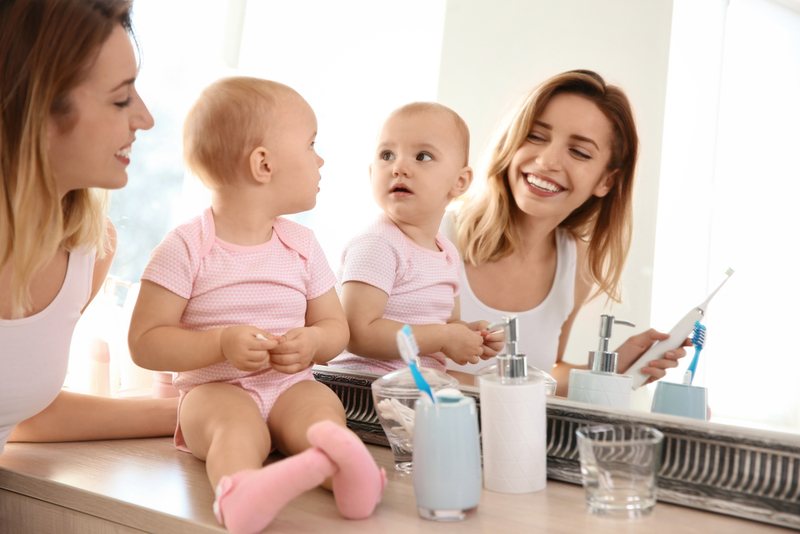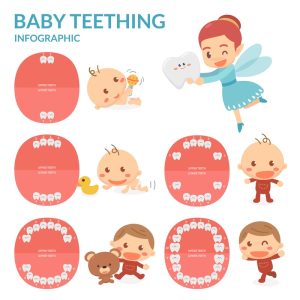You might be tempted to think that teeth are just teeth, but the mouth and all its structures play a significant role in the development and overall health of your child. At Exceptional Dentistry, Dr. James Powell and our team in Palmdale, CA are committed to helping you and your family experience the best quality of life and we believe that starts with being healthy.
Aside from watching for warning signs that could affect your child’s development, a simple place to start is learning to properly take care of your child’s primary and permanent teeth.
Primary & Permanent Teeth: The Tooth Timetable
Before we learn some simple ways to take the best care of your child’s teeth, we think it’s helpful to know what to expect when it comes to the development of primary and permanent teeth.
When it comes to children’s teeth, parents sometimes wonder why baby teeth require much attention since they are destined to fall out anyway. But primary teeth save space for the incoming adult teeth and these teeth ultimately help your child look, chew and speak normally.
When do children start teething?
Primary teeth (aka baby teeth) usually start to pop up when your child is around six months old. But don’t panic if your kiddo is still toothless! That’s because some children are late bloomers and they don’t get teeth until a little after they are one year old.
Typically, the two front teeth on the bottom will be the first to show up and then the four front teeth on top. The rest of their tiny chompers start popping in in pairs (one on the left and one on the right) until all 20 come through.
Once your child is three years old they will have all their baby teeth.
Facial and jaw bone growth happen around the age of four which makes more space for the permanent teeth to come in. So, between the age of 6 and 12, their mouths will have both primary teeth and permanent teeth.
When do children start losing teeth?
Your child’s baby teeth generally start to loosen when they are around five or six and the tooth roots begin dissolving. Early teethers could start having teeth fall out as early as age four.
As you can see from the infographic, tooth loss starts with the top and bottom front teeth (central incisors). It can take a few months for a loose tooth to fall out, so don’t freak out if it happens while your child is eating or sleeping and accidentally swallows it. Hint: it’s best to let nature take its course and allow the tooth to fall out on its own rather than to pull it while the tooth root is still connected.
It’s Raining Baby Teeth
When your child loses a baby tooth, it’s a pretty big deal. Some kids see this as a rite of passage and joining the ranks of their peers.
Tooth loss can be as exciting for your little one as learning to read or ride a bike! Others are nervous when losing their first tooth and it can help to reassure them that for every tooth that comes out, a bigger, “badder” one will take its place! To help your child celebrate this mini rite of passage, you can enlist the help of the tooth fairy.
Here are some fun ways parents have engaged the tooth fairy in their child’s journey:
- Leave a cute toothbrush or a small tooth plushy under their pillow instead of money if this is their first tooth
- Leave a gold coin in an empty dental floss container (you can paint it or add glitter)
- Leave a trail of colorful paper fairy footsteps leading to their bedroom window or the door
- Leave a trail of glitter “fairy dust” on their windowsill
- Leave a note from the tooth fairy decorated with stickers encouraging good oral hygiene to ensure healthy future specimens (the tooth fairy might leave a bigger payment the healthier and stronger the tooth was!)
Taking Care of Your Child’s Primary and Permanent Teeth
When should you start brushing your child’s teeth?
As soon as a tooth comes through it needs to be cleaned. However, when a child is six months old it might be hard to use a toothbrush (if you’re able to, great!). Otherwise, you can simply use a soft wet cloth to wipe their teeth and they may even help you by gnawing at it. At this stage, there’s no need for toothpaste.
Once your little one gets a bit older then you can use a very soft toothbrush.
Choose the Best Type of Toothbrush
Use a soft-bristled toothbrush with a small round head that maneuvers easily in their tiny mouths while cleaning gently around their gums. Making their toothbrush feel comfortable in their mouths will help them get used to and enjoy this daily practice.
Replace the toothbrush whenever the bristles start to lose their shape, so anywhere from one to three months of use is ideal (be sure to replace it after any viral illness). Once their back molars show up, spend some extra time cleaning those back teeth where bacteria and plaque tend to collect.
When is it Time to Use Toothpaste?
Once your child is about 18 months old you can begin to use a pea-sized amount of low-fluoride toothpaste. Flavor can make all the difference, so make sure it’s one your child likes and will look forward to using!
Fruity flavors are often a big hit with our younger patients. You’ll still want them to spit it out and not just swallow it so that they develop the right habits early on. Of course, your child still might accidentally swallow it (particularly when they’re learning) so that’s why you only want to use a tiny amount.
When is it Time to Floss?
Your little one’s teeth will need to be flossed once they have two that are touching. Floss sticks, picks and flavored dental floss can make flossing fun for you and your child.
When Should a Child Visit The Dentist?
A child can see the dentist before they have any teeth, even as a baby if they are having trouble latching. This could be a result of them being tongue-tied and a pediatric dentist can use a laser to painlessly correct the issue.
You may also want to visit a dentist early if your child has some of the red-flags that we mentioned in another post, “WHAT YOU NEED TO KNOW ABOUT YOUR CHILD’S DENTAL HEALTH“.
But if all is well, then we concur with the American Academy of Pediatric Dentistry (AAPD), which recommends that a child goes to the dentist by age one or within six months after the first tooth shows up.
Of course, the dentist will examine their teeth at their first visit but they will also be looking for anything that could affect your child’s oral development. Further, these initial visits help your child get used to going to the dentist and help them with not developing a fear of going.
Develop The Right Oral Health Habits Early-On
It’s no secret that children follow their parents example, which just makes it even more important that you’re setting a good example. Having your child around when you’re brushing and flossing your teeth is a great teaching tool.
As your little one grows, you can encourage them to brush their own teeth first and then you can finish brushing their teeth.
A helpful trick is to sit on the floor with your legs open and have them lay on their back with their head resting on one of your thighs. This really makes brushing their teeth a lot easier for you and helps you get to all their little teeth so the sugar bugs don’t!
As a parent, you probably already know that turning up the FUN dial really helps in transforming a seemingly mundane activity into the highlight of the morning and night. If you feel like you want some more fun ideas then you’re going to love, “7 Ways to Make Brushing Teeth FUN for Your Child“.
What’ve We Learned?
The primary teeth play an important role in a child’s oral development. They help them chew properly so they can eat body-healthy foods like fruits and veggies. Baby teeth help maintain their facial structure so they continue to look adorable and help them talk as their speech develops. Primary teeth prepare the way for permanent teeth and help ensure good oral health and overall health as your child grows.
Healthy baby teeth mean keeping tooth decay and gum disease away so adult teeth can come in in their best shape. Along with regular dental checkups, you can help your child get the best bang for their tooth by teaching them good oral hygiene habits early on.
To get your child’s dental health started on the right foot, call at (661) 349-7725 to schedule a visit, or you can schedule conveniently online. We look forward to helping your little one’s smile develop as healthy as possible!


